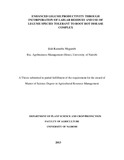| dc.description.abstract | Green manures and crop residues have been used to enhance soil fertility and improve yield. The effect of such organic amendments on the population of soil-borne pathogens is however not well understood. This study was carried out to determine the effect of lablab residues on root rot of bean and the tolerance of different legumes to root rot. Field experiments were carried out at two sites with varying soil fertility in Nandi South district over two seasons. In one of the experiments, lablab residues were incorporated into the soil and the plots planted with beans intercropped with maize. Four bean varieties KK8, KK15, KK072 (tolerant to root rot) and GLP2 (susceptible to root rot) were used. Data collected included soil nutrient status, crop emergence, stand count, incidence of root rot and chafer grubs and yield.
In the second experiment, six legumes; cowpea, common bean, soybean, lablab, groundnut and field pea each with three varieties were evaluated for susceptibility to root rot by planting each legume species in two ecologically diverse sites. Data collected included crop emergence, stand count, root rot incidence, infection of stem bases, incidence of foliar diseases, number of pods per plant, number of seeds per pod and seed yield.
Incorporation of lablab residues caused a 20% increase in total percentage nitrogen in the soil. Highest root rot incidences were observed in plots where the lablab residues were cut and removed in low fertility site. Although there were significant differences in Fusarium infection levels among the residue management options, the pattern was not consistent among the bean varieties and experimental sites. All the bean varieties showed high levels of root rot infection in the stem bases but the root rot tolerant varieties KK15 and KK8 were seen to develop numerous
xiii
adventitious roots just above the point of infection. Significantly higher incidences of chafer grubs (50%) were observed in plots where lablab residues were scattered and incorporated over the whole plot in the low soil fertility site. Highest yields of variety KK15 were observed in plots where lablab residue was incorporated over the whole plot in Kapsengere site. Treatments where lablab was removed and DAP fertilizer applied yielded 70% more biomass than the other treatments.
There was a progressive decline in stand count over time among all legumes evaluated except ground nut. The decline in stand count was more pronounced in common bean than other legumes. Common bean and cowpea were most susceptible and soybean most tolerant. Legume varieties differed in tolerance but there was no definite trend observed in both sites and seasons. Fusarium and Macrophomina were the most common root rot pathogens isolated from both sites, with Kapsengere having a higher frequency of Macrophomina than Koibem. Common bean showed the highest susceptibility to the foliar diseases evaluated. Field pea had the highest yield in both sites and cowpea the lowest. Soybean and lablab had the highest number of pods per plant and cowpea the lowest in both sites and seasons.
The results indicate that incorporation of lablab residues improved soil nutrient status, bean crop growth, yields and crop biomass without significant increase in root rot damage. Uniform incorporation of the residues resulted in better crop performance and the beneficial effect was more pronounced in low fertility site. The performance enhancing benefits of the residues are also available to the intercrop maize. Most of the legume types and varieties screened showed tolerance to root rot. The practice of incorporating lablab residues, alongside the use of root rot tolerant legumes will improve yields for small scale farmers | en |

